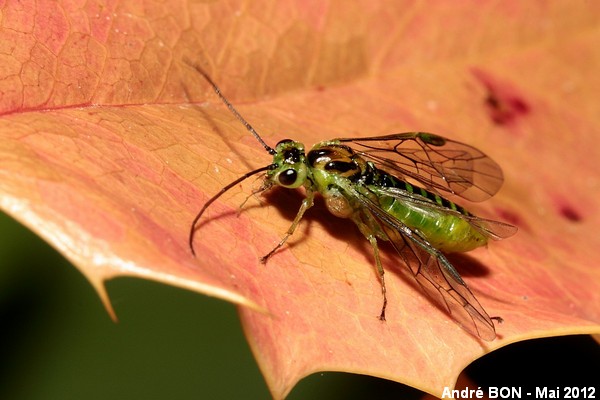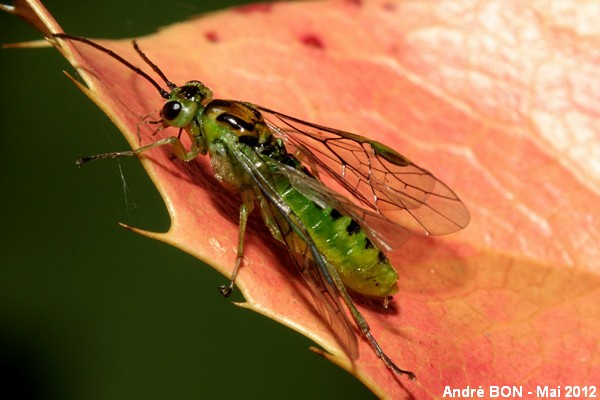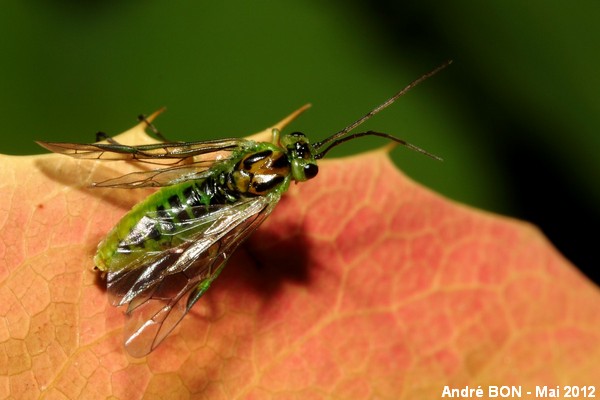


| Nematus (Pteronidea) poecilonotus (Zaddach, 1876) |



|
|
Scientific name: Nematus (Pteronidea) poecilonotus (Zaddach, 1876) Common name: Other names: Other scientific name: Nematus viridescens, Pteronidea poecilonota. French name: Order: Hymenoptera Family: Tenthredinidae Wingspan : 6 to 8 mm. Biotope: Places with Birches (Betula) on which larvae feed. They are pale green with brown median stripes on the head, from vertex to labrum and from vertex to eyes. Geographic area: Western Europe, Central Europe and northern Europe. Observation period : |
Members of the Tenthredinidae family have long antennae with 7 to 9 articles. The Nematinae sub-family is characterized by a non-divided radial cell, an ovoid body and antennae of 9 articles. The key leading to the Nematus and Pteronidea genera indicates a non-constricted anal cell, a non-divided radial cell, a transverso-costal vein located before the basal vein, a clypeus with a deep notch on the anterior margin, three cubital cells, bifid claws and antennae gradually tapering towards the apex. Nematus poecilonotus, previously classified in the Pteronidea genus has tibias III without enlargement or groove, smooth and shiny mesosternum and mesopleura and the third cubital cell is much shorter than the second one. The second cubital cell is rather elongated. It receives the two recurrent vein on the inner side. The stigma is yellow and outlined with dark. The antennae are black. The abdomen is almost completely green with a black median dorsal band. The tibias III are green-yellow, just sometimes with a darkened apex. The underside of the thorax is green-yellow. Nematus (Pteronidea) tibialis is very similar and only differs by completely black tibias III. |
| [To know more about the Nematus (Pteronidea) poecilonotus] [Next picture] [Top] |

|
One quick search on green sawflies quickly lead me to the Rhogogaster genus. This hypothesis has been quickly discarded as the radial cell of the fore wing, clearly not divided, indicates the Nematinae sub-family and does not match the Tenthredininae sub-family. I have found Nematus poecilonotus as a possible species, especially because these pictures were shot on the low growing vegetation located under one Birch tree. The remaining part of the task has been to confirm or deny this identification using the FAUNE DE FRANCE Number 47 book. This has been more complicated than expected as this sawfly is listed in there as Pteronidea poecilonota, that's to say in another genus than Nematus. I guess that there may have been some changes... I have found all the criteria listed in the above description, on the 3 pictures, except the shape of the anal cell, the shape of the anterior margin of the clypeus and the shape of the claws. I have also a doubt about the colour of the stigma which is used at the beginning of the key to tell the species apart. However I have found approved pictures of Nematus (Pteronidea) tibialis with the exact similar colour. The presence of this insect close to a Birch tree and the presence of all the other criteria of the key make me think that the Nematus (Pteronidea) poecilonotus species is highly probable. (a more rigorous approach would have forced me to stay at Nematinae sp.) |
| [To know more about the Nematus (Pteronidea) poecilonotus] [Next picture] [Previous picture] [Top] |

|
The veins of the wings are better visible on this picture. You can also see the claws but I have not enough experience ( or the picture is not sharp enough) to tell if they are bifid. |
| [To know more about the Nematus (Pteronidea) poecilonotus] [Previous picture] [Top] |

|
You can see on this picture (more easily on the non-reduced picture) that the transverso-costal vein is located before the basal vein. |